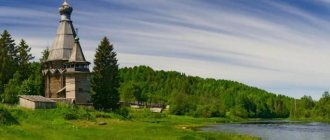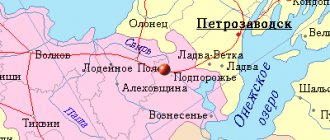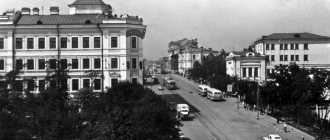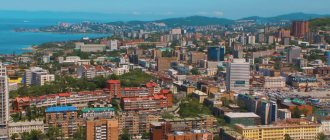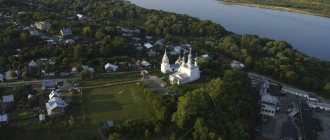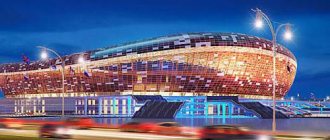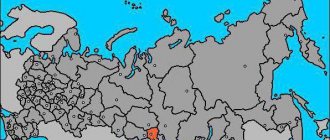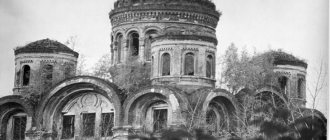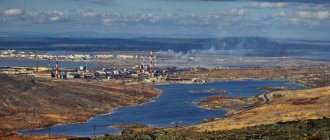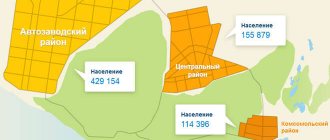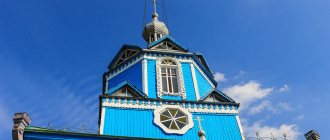Ermolino is an urban settlement located on the Protva River (a tributary of the Oka), 7 km from the Balabanovo railway station (on the Moscow - Bryansk line) and 13 km from the regional center - the city of Borovsk.
In the northeastern part of the Kaluga region, Ermolino borders on the rural settlements of the village of Sovkhoz Borovsky, the village of Sovyaki and the urban settlements of the city of Borovsk and the city of Balabanovo. The area of the municipality is 7.7 sq. km.
The population of the city is 10,179 thousand people.
The convenient geographical location of the city determines the connection with neighboring urban settlements, which is carried out by the federal highway A108 Moscow Big Ring and the Ermolino - Borovsk - Vereya highway, thereby predetermining its significant share in the industrial potential of the district and region.
The leading place in the city's economy is occupied by the woodworking, light and food industries.
Within the boundaries of the city of Ermolino there are lands of various categories: settlement, agricultural, forest fund, water fund. Agricultural lands, namely agricultural land and arable land, occupy about 6% (52 hectares) of the entire territory.
Story
Since time immemorial, people have settled on its banks.
In the past, a working village for textile workers, now the city of Ermolino is located 10 kilometers from the regional center of Borovsk, downstream of the river. Protvy. The inventory list of the Vorsino parish, assigned to the Archangel Cathedral of the Moscow Kremlin, indicates that the parish included the villages of Kuryanovo, Inyutino and Ermakovo (Ermolino) of Borovsky district.
An extract has been preserved from the grant of a charter from Tsar Boris Godunov, given to the Arkhangelsk Cathedral on June 20, 1601. The extract indicates that these settlements were granted to the Arkhangelsk Cathedral by Prince Dmitry Shemyaka “by grandfather” Dmitry Donskoy (9a SEI, vol. 3 No. 51.p. 77-78).
This reference goes back to the times of Dmitry Shemyaka and Dmitry Donskoy, who owned Sukhodol, which occupied the territory on the left bank of the river. Protva from Borovsk and Balabanovo to Nara.
Prince Dmitry Shemyaka led the feudal opposition to Grand Duke Vasily II. After the defeat of Dmitry Shemyaka in the feudal war of 1453, all his lands were taken away by Vasily II, and the charters for these lands were re-affirmed in favor of the church. Next to the estate of the Archangel Cathedral were the lands of the Pafnutiev Monastery, founded in 1444 and which became one of the richest monasteries of the Russian state. The lands that belonged to the monastery were located in 16 counties. During the time of Dmitry Shemyaka, the village of Rusinovo also received the monastery (currently this is one of the streets in Ermolino, where the Church of St. Nicholas the Wonderworker, erected in 1830 in honor of the victory of Russian troops over Napoleon, is being restored.)
Rich in animals and game birds, the Ermolin “purse” attracted Ivan the Terrible and Boris Godunov. Over time, the wealth of the forests became scarce, and the population that was engaged in agriculture increased. They sowed rye and oats, but preference was given to hemp and flax, from which they produced canvas and rope, including for sale. Borovsk monasteries purchased large quantities of canvas.
A sharp turn in the development of villages and settlements began in 1719 and is associated with the name of Peter I and his policy of strengthening the economic and military power of the Russian state. Tsar Peter I issued certificates to enterprising people to open plants and factories. Borovchan residents - the Kapyrin brothers - planned to build a “mining and iron-making” plant in a ravine near the village of Ermolino. Ten years later, the “foundry” produced up to 2 thousand pounds of cast iron. Coal was burned on site, and ore was delivered by alloy from Mozhaisk district, cast iron was transported by barges along the river.
After the abolition of serfdom, the merchant Molchanov built a small manufactory in Ermolino and launched the production of wrapping paper. In the second half of the 18th century, the weaving industry developed significantly in Ermolino and other settlements of Borovsky district. Handicraft weavers were engaged in the manufacture of paper and wool scarves, shawls, aprons and towels, blankets and even carpets.
The largest in Borovsky district was the Rusinovskaya textile factory of Alexandrov.
The former clerk of this factory, Fyodor Isaev, having successfully married the daughter of Pavel Bukharin, the owner of the Ermolinsk distribution office, took over his father-in-law’s capital and invested it in the development of new production, buying several acres of land near the river for next to nothing. In 1880, merchant of the 2nd guild Fyodor Semenovich Isaev received a Patent for opening the Ermolinskaya manufactory, which produces fabrics and printed scarves. Products are exported to the Turkish and Iranian markets and successfully compete with British goods.
The Ermolinsky factory, already at that time, had become one of the largest enterprises in the textile industry in Russia and directly influenced the development of the entire Ermolino and the surrounding villages of Rusinovo, Inyutino, etc. The population finally breaks with agriculture and joins the ranks of the working class. Weaving for Ermolin residents becomes a hereditary craft. The history of the factory is the history of Ermolino - from the Ermolino textile manufactory, the weaving factory "Krestyanka", the Ermolinsky production association, which employed more than three thousand people, to the modern textile enterprise Ermolino OJSC, from the village and workers' settlement to the city of Ermolino, where they live about 10 thousand inhabitants.
Ermolinsky textile workers went through a harsh school of competition, class struggle, wars and economic ruin, years of shock five-year plans and all-Union glory. For valiant and selfless work in honor of the centenary of the enterprise, the team was awarded the Order of the Red Banner of Labor. Hundreds of employees of the enterprise, living labor veterans, were awarded high government awards.
In the harsh 90s, great economic hardships befell the Ermolinsk plant and everyone who worked there and lived in the workers’ village.
But again, having gone through all the trials, as in past years, the Ermolinsk city-forming enterprise received a new birth, the city of Ermolino lives and develops, carefully preserving the best traditions of the textile region, preserving everything that was built by previous generations, increasing the current well-being of the Ermolin residents.
Ermolino - war years
A special page in the history of Ermolino was the years of the Great Patriotic War and 77 days of fascist occupation (from October 15 to December 30, 1941). Many factory workers went to the front, and some joined the extermination squads. (In the first months, more than 500 people; later, more than 1 thousand Ermolin residents went to the front due to conscription). According to verified lists, more than 250 people remained on the battlefields. A participant in the legendary Parade on November 7, 1941 in Moscow was Eremin Ivan Kuzmich. Participants in the Victory Parade on June 24, 1945 were: Kulev Pavel Nikolaevich, Mashurov Nikita Anisimovich, Fokin Petr Maksimovich. Their children, grandchildren, and great-grandchildren still live in Ermolino. According to the lists of 1975 (30th anniversary of Victory in the Second World War), about 1,250 veterans who took part in the battles lived in Ermolino. More than half worked at a textile enterprise, the rest at the Aerodrome, in the Ermolino industrial enterprise, and in schools. They restored the factory and social and cultural facilities, built a housing stock, and educated the younger generation by their own example. Of the living combatants - 8 people, 170 are veteran home front workers and juvenile prisoners.
Fierce battles took place on Ermolinsky soil; the 110th and 113th militia divisions bravely repelled the onslaught of the numerically superior enemy. In memory of those events, there are five mass graves and obelisks on the territory of the municipality of Ermolino. The fate of ten Heroes of the Soviet Union is connected with the Ermolinsky (Inyutinsky) airfield. Among them are Mikhail Rodionov, Ivan Kalabushkin, Ivan Kozhedub. The heroic pilot Vodopyanov flew to the airfield several times; Vasily Stalin visited here in the early 50s. The famous pilot Valentina Grizodubova created the Ermolinsky flying club at the airfield.
On the basis of buildings built back in the Soviet years, renovated and equipped in the light of the requirements of the time, children's preschool and school institutions, a large House of Culture and an art school, a stadium and a gym are successfully functioning. Creative groups and Ermolinsky athletes, as in previous times, delight their fans and take worthy places in various competitions and competitions. The former vocational school, which trained personnel for the textile industry for more than half a century, has become the only technical school in the region that produces specialists for many branches of industry and agriculture in the region.
Much socially significant work among the population is carried out by the Center for Social Assistance to Families and Children, various public associations, local history and school museums. Since 1933, Ermolino began publishing its own local newspaper. It had a large circulation and bore the symbolic name “Textile Worker,” like all Ermolin sports teams and public organizations. In 2004, the newspaper was published under the no less symbolic name “Corner of Russia”.
According to established tradition, on the second Sunday of June, Ermolino City Day is celebrated on the same day as the professional holiday of textile industry workers, which symbolizes harmony, mutual understanding and cooperation in resolving our common affairs, and faith in a worthy tomorrow.
Source
Ermolino
The lands on which the city of Ermolino is located today were part of Sukhodol from the 14th century, which was mentioned in the Spiritual Charter of Ivan I Kalita in 1328. Sukhodol occupied the territory from the Nara River to the Protva River, from the village of Fominskoye to Borovsk. According to the will of Ivan Kalita’s grandson Dmitry Donskoy, “Sukhodol s-Ystyu, s Istervyu” went to his son Yuri Dmitrievich, Prince of Zvenigorod and Galitsky, and later to his son, Dmitry Yuryevich Shemyaka. It was on the lands of the Sukhodolsky camp of the Borovsky district, owned by Dmitry Shemyaka, that the famous Pafnutyev-Borovsky monastery was founded in 1444 by the Monk Pafnutius.
The first written mention of Ermolino is an extract from the rim charter of Tsar Boris Godunov dated June 20, 1601. According to this document, Prince Dmitry Yuryevich Shemyaka, “by grandfather” Dmitry Donskoy, granted these possessions to the Archangel Cathedral.
After many years of war between Vasily II the Dark and Dmitry Shemyaka for the great reign, the latter was poisoned in Veliky Novgorod on the orders of Vasily the Dark and died on July 17, 1453. After the death of D. Shemyaka, all the lands belonging to him were taken away by Vasily II, the charters for these lands were re-affirmed in favor of the church.
Rich in animals and game birds, the Ermolin “purse” attracted Ivan IV the Terrible and Boris Godunov in the 16th century, who visited the Pafnutev Monastery located on the lands of Sukhodol. Over the years, the wealth of the forests became scarce, and the population, mainly engaged in agriculture, increased. Local peasants sowed rye and oats, but preferred hemp and flax, from which they produced canvas and rope, including for sale. Borovsk monasteries purchased large quantities of canvas.
The next mention of Ermolino can be considered an entry in the Spread Book of local and patrimonial lands of Borovsky district during the patrol of 1613. The inventory list (1705) of the Vorsino parish, assigned to the Archangel Cathedral of the Moscow Kremlin, indicates that the parish included the villages of Kuryanovo, Inyutino and Ermakovo (Ermolino).
The turnaround in the economy of Ermolino and neighboring villages began in 1719 and is associated with the name of Peter I, who issued letters to enterprising people to open plants and factories. Among these enterprising people were Borovsk residents - brothers Vasily and Agafon Kapyrin, who planned to build a “mining and iron-making” plant in a ravine near Ermolino. By decree of Peter I, “state Ermolin men” were assigned to the plant. In the same year, the first products were produced, and after 10 years the plant produced up to 2,000 pounds of cast iron. Coal was burned on site, and ore was delivered by alloy from Mozhaisk district, cast iron was transported by barges along the river.
In the second half of the 18th century, the weaving industry developed in Ermolino. Historian V.M. Kashkarov pointed out that weaving was most developed in Maloyaroslavets and Borovsk districts. Handicraftsmen were busy making shawls, paper and wool scarves, aprons, towels, blankets and even carpets.
In the second half of the 19th century, after the abolition of serfdom, the Borovsk merchant Molchanov built a small manufactory for the production of wrapping paper in Ermolino.
In the 19th century, the largest textile factory in Borovsky district was Aleksandrov’s Rusinovskaya textile factory. Fyodor Isaev, a former factory clerk, successfully married the daughter of the owner of the Ermolinsky distribution office, Pavel Bukharin. Having successfully invested his father-in-law's capital, he bought several acres of land near the river for next to nothing and founded a new production. In 1880, the merchant of the 2nd guild Fyodor Semenovich Isaev received a Patent for opening the Ermolinskaya manufactory. The company produced fabrics and printed scarves, its products were exported to the Turkish and Iranian markets, successfully competing with English manufacturers.
By the end of the 19th century, the Ermolinsk factory received the greatest development, becoming one of the largest enterprises in the textile industry of Russia. She influenced the further development of not only Ermolino, but also the neighboring villages of Rusinovo, Inyutino and others. Peasants are less and less involved in farming and are joining the ranks of factory workers. Weaving here becomes a hereditary craft. The history of the development of the Ermolinsk factory is the history of Ermolino - from the Ermolinsk textile manufactory, the weaving factory "Krestyanka", the Ermolinsk production association, which employed more than 3 thousand people, to the modern textile enterprise JSC Ermolino, from the village and workers' settlement to the city of Ermolino .
In 1928, the village of Ermolino received the status of a village. From the 1930s – 1940s. the village grew rapidly, connecting with the villages of Rusinovo and Inyutino. A hospital, an outpatient clinic, a House of Culture for 650 places, a seven-year school, and in 1934 a ten-year school were built. Since 1933, the local newspaper “Textilshchik” began to be published in Ermolino (in 2004 the newspaper was published under the name “Corner of Russia”). The population at this time reached 12,000 people.
During the Great Patriotic War, from October 15, 1941, Ermolino was occupied by German troops. The building of the House of Culture housed a German stable. On December 31, 1941, the village was liberated by units of the 43rd Guards Latvian Rifle Division of Riga.
Since 1944, Ermolino has been part of the Borovsky district of the Kaluga region. On December 26, 1967, the Krestyanka weaving and finishing factory was renamed the Ermolinsky Cotton Mill.
In honor of the 100th anniversary of the Ermolinsk factory, the company’s staff was awarded the Order of the Red Banner of Labor for their valiant and selfless work. Hundreds of company employees were awarded high government awards.
1990s were very difficult for the Ermolinsky plant, for all its workers and residents of the village. But, having gone through severe trials, the Ermolinsk city-forming enterprise received its new birth. Many new enterprises have appeared on the territory of the urban settlement “City of Ermolino”. Preschool and school institutions, a House of Culture, an art school, a stadium, and a gym are successfully operating on the basis of buildings built back in the Soviet years. The former vocational school, which trained personnel for the textile industry for more than half a century, became the only technical college in the region that graduates specialists for many branches of industry and agriculture.
Ermolino city
Ermolino is an urban settlement located on the Protva River (a tributary of the Oka), 7 km from the Balabanovo railway station (on the Moscow - Bryansk line) and 13 km from the regional center - the city of Borovsk.
In the northeastern part of the Kaluga region, Ermolino borders on the rural settlements of the village of Sovkhoz Borovsky, the village of Sovyaki and the urban settlements of the city of Borovsk and the city of Balabanovo. The area of the municipality is 7.7 sq. km.
The population of the city is 10,179 thousand people.
The leading place in the city's economy is occupied by the woodworking, light and food industries.
Within the boundaries of the city of Ermolino there are lands of various categories: settlement, agricultural, forest fund, water fund. Agricultural lands, namely agricultural land and arable land, occupy about 6% (52 hectares) of the entire territory.
Single-industry town Ermolino
Requirements for the project and initiator (borrower)
- initiator (borrower) – individual entrepreneur or legal entity, resident of the Russian Federation;
- the initiator has no overdue debt to the budget and funds;
- as a result of the implementation of the Investment Project, investments should be made and new jobs should be created;
- lack of dependence of the project on the activities of the city-forming enterprise.
Restrictions
- the Fund's participation in the project is no more than 80% of the total cost of the project;
- the Fund's funds can only be used for capital investments;
- the presence in relation to the single-industry town of a general agreement on development cooperation concluded with a constituent entity of the Russian Federation (on the joint implementation of a comprehensive project).
An investment project in a single-industry town is understood as an investment project carried out in the form of capital investments by a legal entity or individual entrepreneur on a plot of territory consisting of one or more land plots within the boundaries of a single-industry town, as well as on areas of territory adjacent to the borders of a single-industry town within the boundaries of an industrial, industrial , technological or agro-industrial park, or if part of the production capacity of these persons is located outside the territory of the single-industry town, but is a component of a single production process aimed at achieving a common economic result (production of goods, performance of work, provision of services) and simultaneously meets the following requirements:
- the project is not an investment project for the reconstruction, technical re-equipment, modernization and (or) additional equipment of the city-forming enterprise of a single-industry town;
- the annual cost of goods (work, services) purchased from the city-forming enterprise of the single-industry town does not exceed 50% of the annual cost of all goods (work, services) purchased for the purpose of implementing the investment project;
- annual revenue from the sale of goods (work, services) of the city-forming enterprise of a single-industry town does not exceed 50% of the annual revenue received from the sale of goods (work, services) produced (performed, provided) as a result of the implementation of the investment project.
Obtaining the status of an industrial park is planned in 2022
Project initiator: K-Agro LLC and the Government of the Kaluga Region represented by the regional Ministry of Economic Development Project purpose: placement of enterprises of various industries, warehouse real estate. Land rights: property of K-Agro LLC Land category: industrial lands Investments: up to 58 billion rubles. Jobs: more than 5,500 jobs.
The total area of the industrial park is 288 hectares, of which:
- 1.5 hectares provided to investors
- 86.5 hectares allocated for communication corridors
- 200 hectares free for investors
Location
- The park is located along the federal highway A-108 “Bolshaya Betonka”
- 15 km from Obninsk, 95 km from Moscow and 95 km from Kaluga
- Highway M-3 "Moscow-Kyiv" at a distance of 5 km. Capacity of 1,250 cars per hour with four-lane traffic organization and the prospect of increasing to six lanes (to Kaluga)
- Highway M-1 “Moscow-Minsk” at a distance of 40 km
- The customs terminal is located on the western site of the Vorsino industrial park at a distance of 15 km
- Vorsino railway station is located 8 km away. Active. Work is underway on the station's track development
- The Obninskoye railway station is located 20 km from the industrial park
Distance to international airports
- “Sheremetyevo” – 120 km (approximate travel time – 2 hours)
- “Vnukovo” – 70 km (approximate travel time – 1 hour)
- “Domodedovo” – 110 km (approximate travel time – 1.5 hours)
Nearest settlements
- Ermolino (population 10 thousand people)
- Obninsk (population 118 thousand people)
- Balabanovo (population 25 thousand people)
- Naro-Fominsk (population 67 thousand people)
High population density
- More than 400 thousand people live within a radius of 50 km
- More than 6 million people live within a radius of 100 km
- More than 25% of the Russian population lives within a radius of 600 km
Residents of the industrial park
- KF "Mikaello", LLC - production of confectionery products
Infrastructure
Internal engineering infrastructure is in the design stage. The following mainline capacities are currently available:
Power supply - from the 110/35/10 kV Rusinovo substation,
Gas supply - from the medium pressure gas pipeline of Maloyaroslavetsmezhraigaz JSC (steel pipe Æ 159 mm)
Water supply - from the networks of the State Enterprise "Kalugaoblvodokanal", - organization of your own well
Water disposal - from the networks of the State Enterprise "Kalugaoblvodokanal" (Ermolinsky treatment facilities)
Conditions for accommodation on the territory of the industrial park
- placement for a fee (calculated individually for each investor)
Interesting Facts
- The status of a single-industry town was assigned to the city of Ermolino on January 21, 2022. This status is assigned to settlements with a population of more than 3 thousand people, of which about 20% are employed at the enterprises of one company (city-forming enterprise).
- The status of a single-industry town gives additional competitive advantages to companies located within the city boundaries. First of all, this is support from the Single-Industry Towns Development Fund (FMD):
- provision of funds in the form of a loan (from 5 million to 1 billion rubles for a period of up to 15 years with a deferment on loan repayment for up to 3 years at 0% per annum (if the loan is above 250 million rubles - 5% per annum);
— co-financing of expenses of constituent entities of the Russian Federation and municipalities for the construction and (or) reconstruction of infrastructure facilities.
- In the future, on the territory of the single-industry town of Ermolino, it is planned to create a territory with a preferential regime - a territory of advanced socio-economic development (PSED), which will allow residents, among other things, to claim tax benefits (reduced income tax rates, property taxes, tax rates in state funds).
Brief historical background
The inventory list of the Vorsino parish, assigned to the Archangel Cathedral of the Moscow Kremlin, indicates that the parish included the villages of Kuryanovo, Inyutino and Ermakovo (Ermolino) of Borovsky district.
An extract has been preserved from the grant of a charter from Tsar Boris Godunov, given to the Arkhangelsk Cathedral on June 20, 1601. The extract indicates that these settlements were granted to the Arkhangelsk Cathedral by Prince Dmitry Shemyaka “by grandfather” Dmitry Donskoy (9a SEI, vol. 3 No. 51.p. 77-78). This reference goes back to the times of Dmitry Shemyaka and Dmitry Donskoy, who owned Sukhodol, which occupied the territory on the left bank of the river. Protva from Borovsk and Balabanovo to Nara.
Prince Dmitry Shemyaka led the feudal opposition to Grand Duke Vasily II. After the defeat of Dmitry Shemyaka in the feudal war of 1453, all his lands were taken away by Vasily II, and the charters for these lands were re-affirmed in favor of the church.
Next to the estate of the Archangel Cathedral were the lands of the Pafnutiev Monastery, founded in 1444 and which became one of the richest monasteries of the Russian state. The lands that belonged to the monastery were located in 16 counties. During the time of Dmitry Shemyaka, the village of Rusinovo also received a monastery (currently this is one of the streets in Ermolino, where the Church of St. Nicholas the Wonderworker, erected in 1830 in honor of the victory of Russian troops over Napoleon, is being restored).
Rich in animals and game birds, the Ermolin “purse” attracted Ivan the Terrible and Boris Godunov. Over time, the wealth of the forests became scarce, and the population that was engaged in agriculture increased. They sowed rye and oats, but preference was given to hemp and flax, from which they produced canvas and rope, including for sale. Borovsk monasteries purchased large quantities of canvas.
After the abolition of serfdom, the merchant Molchanov built a small manufactory in Ermolino and launched the production of wrapping paper. In the second half of the 18th century, the weaving industry developed significantly in Ermolino and other settlements of Borovsky district. Handicraft weavers were engaged in the manufacture of paper and wool scarves, shawls, aprons and towels, blankets and even carpets.
The largest in Borovsky district was the Rusinovskaya textile factory of Alexandrov.
The former clerk of this factory, Fyodor Isaev, having successfully married the daughter of Pavel Bukharin, the owner of the Ermolinsk distribution office, took over his father-in-law’s capital and invested it in the development of new production, buying several acres of land near the river for next to nothing. In 1880, merchant of the 2nd guild Fyodor Semenovich Isaev received a Patent for opening the Ermolinskaya manufactory, which produces fabrics and printed scarves. Products are exported to the Turkish and Iranian markets and successfully compete with British goods.
The coat of arms of the urban settlement "Ermolino City" was approved by decision No. 217 of the City Duma on December 26, 1999 and entered into the State Heraldic Register of the Russian Federation with the assignment of registration number No. 696.
The basis of the coat of arms of the city of Ermolino was its geographical location on the bend of the Protva River, depicted in the coat of arms with a winding silver ribbon.
Silver in heraldry
A symbol of simplicity, perfection, wisdom, nobility, peace, mutual cooperation.
Blue color in heraldry
A symbol of honor, glory, devotion, truth, beauty, virtue and clear skies.
The Ermolinsky Airlines cargo airport, which is allegorically depicted by a flying oriole, is inextricably linked with the sky.
A bird with a shield flying upward shows Ermolino’s aspiration to the future, not forgetting the origins of the formation of the city, which took place around the spinning and weaving factory, depicted in the shield as a shuttle.
Red color
A symbol of labor, life-affirming strength, courage, celebration and beauty.
Gold
A symbol of strength, greatness, intelligence, generosity.
Green color
Shows the nature surrounding the city, rich in fields, forests, meadows, as well as agriculture. Green is also a symbol of hope, life and rebirth.
The placement of the shuttle in a separate shield symbolizes the special significance of weaving in the history of Ermolino.
The Ermolino coat of arms was developed with the assistance of the Union of Heraldists of Russia.
Authors of the coat of arms
Idea
Konstantin Mochenov (Khimki), Sergey Isaev (Moscow), Vadim Blazhenkov (Ermolino)
Artist
Robert Malanichev (Moscow).
Coat of arms
The coat of arms of the urban settlement "Ermolino City" was approved by decision No. 217 of the City Duma on December 26, 1999 and entered into the State Heraldic Register of the Russian Federation with the assignment of registration number No. 696.
The basis of the coat of arms of the city of Ermolino was its geographical location on the bend of the Protva River, depicted in the coat of arms with a winding silver ribbon.
Silver in heraldry
A symbol of simplicity, perfection, wisdom, nobility, peace, mutual cooperation.
Blue color in heraldry
A symbol of honor, glory, devotion, truth, beauty, virtue and clear skies.
The Ermolinsky Airlines cargo airport, which is allegorically depicted by a flying oriole, is inextricably linked with the sky.
A bird with a shield flying upward shows Ermolino’s aspiration to the future, not forgetting the origins of the formation of the city, which took place around the spinning and weaving factory, depicted in the shield as a shuttle.
Red color
A symbol of labor, life-affirming strength, courage, celebration and beauty.
Gold
A symbol of strength, greatness, intelligence, generosity.
Green color
Shows the nature surrounding the city, rich in fields, forests, meadows, as well as agriculture. Green is also a symbol of hope, life and rebirth.
The placement of the shuttle in a separate shield symbolizes the special significance of weaving in the history of Ermolino.
The Ermolino coat of arms was developed with the assistance of the Union of Heraldists of Russia.
Authors of the coat of arms
Idea
Konstantin Mochenov (Khimki), Sergey Isaev (Moscow), Vadim Blazhenkov (Ermolino)
Artist
Robert Malanichev (Moscow).
general information
The city of Ermolino is located in the Borovsky district in the northeastern part of the Kaluga region as part of the urban settlement "City of Ermolino" and borders on the rural settlements of the village of Sovkhoz Borovsky, the village of Sovyaki and the urban settlements of the city of Borovsk and the city of Balabanovo.
The city of Ermolino is located on the Protva River (a tributary of the Oka River), 7 km from the Balabanovo railway station, 5 km. southwest of the Moscow region, is a rapidly developing industrial, cultural city not only in the Borovsky district, but also in the Kaluga region as a whole.
The convenient geographical location of the city determines the connection with neighboring urban settlements, which is carried out by the federal highway A108 Moscow Big Ring and the Ermolino - Borovsk - Vereya highway, thereby predetermining its significant share in the industrial potential of the district and region.
Within the boundaries of the Municipal State Enterprise “City of Ermolino” there are lands of various categories: the settlement of the city of Ermolino, agricultural purpose, forest fund, water fund. Agricultural lands, namely agricultural land and arable land, occupy about 6% (52 hectares) of the entire territory.
The city of Ermolino is surrounded by forests from the north, south, east, mainly coniferous-deciduous. The most common tree species are: birch, spruce, pine, oak, linden, aspen, hazel. Forests decorate the city's landscape, and therefore many vacationers and nature lovers come here in winter and summer.
The forests are rich in animals and birds. Of the animals inhabiting forests, the most typical are moose, the forest beauties. There are fox, white hare, squirrel, and badger. The most common birds are black grouse, wild duck, and capercaillie. In winter, vacationers hear the fractional sounds made by woodpeckers in the forest, and in summer the forest is full of bird voices.
On warm spring and summer nights, the creaking voices of corncrakes can be heard from the high wheat fields, and from afar and from the nearby bushes around the ponds, the trills of nightingales rush incessantly. Birds of prey include the falcon and the hawk. The Protva River was once famous for crayfish, when its water was pearly clear. In it and other reservoirs of the city there are: pike, perch, roach, ruffe, burbot, chub.
Source
Economy
Among the city's enterprises:
Near the city there is an active airfield that serves the aviation regiment of the Ministry of Internal Affairs of the Russian Federation and a squadron of the Strategic Missile Forces (Strategic Missile Forces).
Articles
: Coat of arms | Anthem | History | Population | Territorial division | Flag
Useful
See what “Ermolino (city)” is in other dictionaries:
Ermolino - Ermolino: Belarus Ermolino village in the Verkhnedvinsky district of the Vitebsk region. Russia Ermolino village in the Petushinsky district of the Vladimir region. Ermolino village in the Vologda district of the Vologda region. Ermolino village in Gryazovets district... ... Wikipedia
Ermolino (meanings) - Ermolino Ermolino city in the Borovsky district of the Kaluga region Ermolino village in the Taldomsky district of the Moscow region Ermolino village in the Gatchina district of the Leningrad region Ermolino village in the Novgorod district of the Novgorod region Ermolino ... ... Wikipedia
Ermolino (Borovsky district) - This term has other meanings, see Ermolino. City Ermolino Flag Coat of Arms ... Wikipedia
Ermolino (Kaluga region) - This term has other meanings, see Ermolino. City Ermolino Flag Coat of Arms ... Wikipedia
Ermolino (station) - This term has other meanings, see Ermolino. Coordinates: 57°05′43.81″ N. w. 41°14′40.31″ E. d. / 57.095503° s. w. 41.244531° E. d... Wikipedia
Alexandrov (city) - City of Alexandrov Flag Coat of Arms ... Wikipedia
Zhukov (city) - City of Zhukov Coat of arms ... Wikipedia
Vidnoye (city) - City Vidnoye Flag Coat of Arms ... Wikipedia
Zhizdra (city in Kaluga region) - City of Zhizdra Coat of arms ... Wikipedia
Flag of Ermolino - Flag of the urban settlement "City of Ermolino" Ermolino Borovsky district Kaluga region Russia ... Wikipedia
Source
